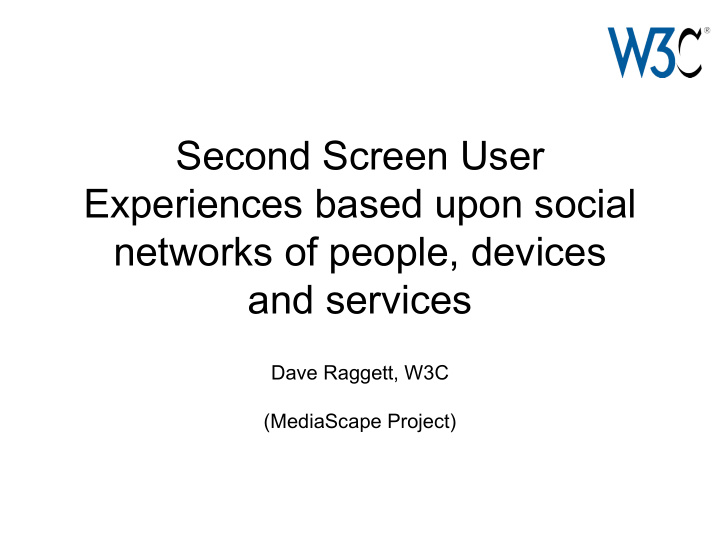



Second Screen User Experiences based upon social networks of people, devices and services Dave Raggett, W3C (MediaScape Project)
MediaScape • European FP7 project – Engaging multiscreen single and multi-user experiences for live and timeshifted content – Based upon web technologies • Members include: – BBC, Bayerischer Rundfunk, NEC, W3C, Vicomtech-IK4, IRT and Norut • More at http://www.mediascapeproject.eu/ MediaScape 2
MediaScape MediaScape 3
Use Case* • John is watching a live sports event on his TV • John's phone notifies him to start a complementary news service – He agrees and it appears as an overlay on his TV – He invites his friend Anne to join this service • She lives the other side of the city • She gets the invitation on her phone – She accepts • John and Anne now share the same experience – They can exchange comments via their phones MediaScape 4 * Many more use cases in the paper!
Requirements • Social connection (John and Anne) • Associating TV and phone • Allowing phone to know what is being shown on the TV • Sending notifications across devices • Adapting user experience to the device • Synchronizing TV and phone • Overlaying broadcast content – Alternative compositions based upon tiling MediaScape 5
How does it work? • The TV and phone are registered as part of their owner's social network • Services implemented as HTML5 apps – with responsive design for device adaptation • Social network server tracks context – people's status (home, travelling, work, ...) – which of their devices are online – what programs they are watching – Server support for message passing • Federated social network – John and Anne may be on different servers – You control your privacy MediaScape 6
What's needed? • Each device needs an agent to be part of the social network – HTML Service Workers • Execute in background akin to Android services • Designed to minimize battery drain on mobile devices – Web Sockets (great for async messaging) • Each app is part of the program session – Includes MediaScape JavaScript library • Exposes social API and shared context MediaScape 7
Synchronization • Aim: synchronize user experience across devices to within 30 mS using JavaScript • Social network server measures latency to each device • Play button sends play request to server • Server sends play command to devices along with a latency dependent delay – So that all devices execute command at same time • Devices adjust play back rate to their system clock – HTML5 audio & video element playbackRate property • Ask me for a demo in the break MediaScape 8
Local vs Remote Messaging • Local peer to peer discovery and messaging – Local network service discovery (DAP WG) – Raw Sockets (SysApps WG) – NFC handover to WiFi (NFC WG) – WebRTC (WebRTC WG) • But issues with device support and local discovery • Server based approach is simpler and more reliable – Relies on web sockets – Avoids challenges of firewalls – Users know where devices are in their homes • JavaScript library can in principle hide differences between local and remote messaging – A question of the appropriate abstraction layer MediaScape 9
Questions? MediaScape 10
Recommend
More recommend